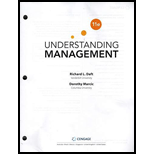
Concept explainers
Chris Dykstra, responsible for loss prevention at
Electronics took a deep breath before he launched into
making his case for the changes that he was proposing to
the company's shoplifting policy. He knew that convincing
Ross Chenoweth was going to be a hard sell. Ross, the
president and CEO was the son of the founder of the local,
still-family-owned consumer electronics chain based in
Phoenix, Arizona. He'd inherited not only the company,
but also, his father's strict moral code.
"I think it's time to follow the lead of other stores,"
Chris began. He pointed out that most Other retailers
didn't bother calling the police and pressing charges
unless the thief had shoplifted merchandise worth more
than $50 to $100. In contrast, Westwind currently had a
zero-tolerance policy toward theft that Ross's father had
put in place when he started the business. Chris wanted
to replace that policy with one that prosecuted only
individuals between IS and 65 who had stolen more than
$20 worth of goods, and who had a previous history of
theft at Westwind. In the case of first-time culprits under
IS or over 65, he argued for letting them Off With a strict
warning, regardless of the value of their ill-gotten goods.
Repeat offenders would be arrested.
"Frankly, the local police are getting pretty tired Of
having to come to Our stores every time a teenager sticks a
CD in his jacket pocket," Chris pointed out. "And besides,
we just afford the costs associated with prosecuting
everyone." Every time he pressed charges against a
shoplifter who'd made Off with a $10 item, Westwind
lost money. The company had to engage a lawyer and
pay employees Overtime for their court appearances. In
addition, Chris was looking at hiring more security guards
to keep up with the workload. Westwind was already in
a losing battle at the moment with mass retailers who
were competing all too successfully on price, so passing on
the costs of its zero-tolerance policy to Customers wasn't
really an option. " Let's concentrate on catching dishonest
employees and those organized-theft rings. They're the
ones who are really hurting us," Chris concluded.
There was a long pause after Chris finished his
carefully prepared speech. Ross thought about his recently
deceased father, both an astute businessman and a person
for whom honesty was a key guiding principle. If he
were sitting here today, he`d no doubt say that theft was
theft—that setting a minimum was tantamount to saying
that stealing was acceptable, just as long as you steal
too much. He looked at Chris. "You know, we've both got
teenagers. Is this really a message you want to send out,
especially to kids? You know as well as I do that there's
nothing they like better than testing limits. It's almost an
invitation to see if you can beat the system." But then Ross
faltered as he found himself glancing at the latest financial
figures on his desk—another in a string of quarterly losses.
If West-wind went under, a lot of employees would be
looking for another way to make a living. In his heart, he
believed in his father's high moral standards, but he had to
ask himself: Just how moral could Westwind afford to be?
Continue Westwind's zero-tolerance policy toward
shoplifting. It's the right thing to do—and it Will pay
Off in the end in higher profitability because the chain's
reputation for being tough on crime Will reduce overall
losses from theft.
Trending nowThis is a popular solution!

Chapter 15 Solutions
Understanding Management (11th Edition), Standalone Book
- Question 2/60 Correction is always better than: Maintenance Containment Root cause identification Preventionarrow_forwardQuestion 47 / 60 Root cause is related to: The "x" on y=f(x) The "y" on y=f(x) The "=" on y=f(x) The "f" on y=f(x)arrow_forwardQuestion 58/60 Ishikawa is more applicable to projects related to lead time. This statement is: True Falsearrow_forward
- Question 49 / 60 Lean Six Sigma is focused on solving highly complex problems. This statement is: False Truearrow_forwardQuestion 60 / 60 Lean Six Sigma guarantees that all problems can be solved. This statement is: False Truearrow_forwardQuestion 23/60 Sigma Level is is used to evaluate how stable my process is. This statement is: True Falsearrow_forward
- Question 24/60 Lean Six Sigma is focused on problems that present low complexity. This statement is: False Truearrow_forwardQuestion 19/60 Control Charts are used to evaluate process stability. This statement is: False Truearrow_forwardQuestion 18/60 We must find the root cause in a Lean Six Sigma project. This statement is: False Truearrow_forward
- Question 17/60 Without data you cannot validate root causes. This True False statement is:arrow_forwardQuestion 16/60 Two of the Measurement System Analysis dimensions discussed in this training are Repeatability and Reproducibility. This statement is: True Falsearrow_forwardAverage is important and always sufficient in a baseline analysis of the process. This statement is: False Truearrow_forward
 Management, Loose-Leaf VersionManagementISBN:9781305969308Author:Richard L. DaftPublisher:South-Western College Pub
Management, Loose-Leaf VersionManagementISBN:9781305969308Author:Richard L. DaftPublisher:South-Western College Pub Understanding Management (MindTap Course List)ManagementISBN:9781305502215Author:Richard L. Daft, Dorothy MarcicPublisher:Cengage Learning
Understanding Management (MindTap Course List)ManagementISBN:9781305502215Author:Richard L. Daft, Dorothy MarcicPublisher:Cengage Learning

